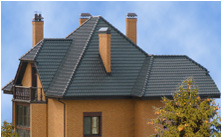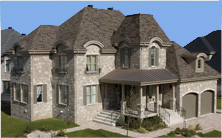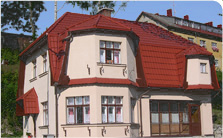Thermal insulation of roof
Thermal insulation of roof
Roof - is the top of the building envelope, consisting of a supporting part and the roof, which may be flat or pitched. Some of them prefer depends largely on climatic conditions and traditions. For example, a pitched roof of old preferred a rainy Europe, and the flat - in the arid Central Asia.
Flat roofs can be either from the attic, and without it (the combined coverage), and the carrier coating is most often used corrugated steel plate or concrete slab. In Russia, such roofs are widely distributed in both the residential and in the construction industry. However, we know that it was flat roofs series of panel apartment buildings due to design flaws and poor workmanship are noted for poor waterproofing and the increased heat loss.
Pitched roof supports special design, consisting of sheathing, directly supporting roofing, and roof trusses, transferring the load weight of the roof, snow, wind and other things on the walls and internal support. In a pitched roof is of considerable advantage - the possibility of the device underneath the additional loft or attic.
The device of modern roof every constructive element has certain protective functions. Roofing - the top element of the roof that protects the building from the weather, that is performing the waterproofing function. All variety of materials for roof coverings may be classified as follows: tile, slate, soft roof, metal roof.
Any roofing material has its own characteristics, which determine the scope of its application. Thus, it is extremely reliable and efficient shingles for centuries used for pitched roofs. Much less stable, but cheap and easy to install slate suitable for pitched roofs, and for roofs with minimal slope.
Soft roof - the code name designs for devices that use roll materials, polymeric membranes, mastic material, soft (bituminous) roof tiles. Modern soft roofing materials, generators on the roof surface a solid tight carpet can provide a waterproof, even on flat roofs.
Metal roofs are also used for two types of roofs: Sheet (roll) galvanized steel or corrugated sheet - a flat roof, and metal and a coating of non-ferrous metals (copper, aluminum, zinc-titanium alloy) - in pitched.
Provides a layer of roof insulation, made of special materials with low thermal conductivity.
As fencing design, the roof is affected by different temperatures. Typically, the temperature of its bottom surface (ceiling) is close to room temperature. At the same time outside surface temperature varies in a very broad range: from -50 ° C in winter to +100 ° C on a sunny summer day. In this case, the roof shall be securely protect the interior of the building from temperature fluctuations, protecting from the cold in winter and in summer from the heat.
Thermal insulation of the roof plays a significant role in enhancing the comfort of the room, improving its microclimate. In addition, properly chosen insulation increases the thermal resistance of the enclosing structure - coating that helps reduce heating costs by reducing heat loss.
When selecting insulation materials for different types of roofs should be aware that their life is substantially affected by temperature and humidity conditions, the possibility of capillary and diffusion wetting, and the impact of mechanical stress.
Insulating material must retain its properties for a long time, have biopersistence, water resistance, not to allocate during the operation of toxic and unpleasant smelling substances, comply with fire safety requirements.
By insulating materials in flat roof structures place high demands on the mechanical strength, particularly compression, and peel the layers in order to avoid violations of the heat insulating layer when walking people, snow and wind loads.
On these indicators as a heat-insulating layer can be used polystyrene plates, foamed glass, rigid fiberglass boards, foam and mineral wool.
Polystyrene plates until recently been widely used for insulation of flat and pitched roofs, and attics, even in spite of their shortcomings are significant, as very little water vapor permeability and flammability.
Foamed glass, without a doubt, an excellent material for flat roofs. But it is rarely used because it is quite expensive.
Popular in Russia because of the affordable price negidrofobizirovannye brand of glass wool has too much water absorption, to the same over time they lose their strength due to shrinkage.
Plates of mineral wool on the basis of basaltic rocks due to the special structure with a chaotic arrangement of tightly coupled fibers possess such a combination is very useful for thermal insulation properties, such as low thermal conductivity, durability, good vapor transmission, high resistance to external mechanical influences and their own strains, as well as excellent sound insulation .
Because of the hydro phobyzing soaking water absorption of the mineral wool is not more than 1,5% by volume.
In addition, mineral wool is classified as non-combustible materials that can withstand temperatures above 1000 ° C. While the binder is burned at a temperature of 250 ° C, the fibers remain intact, while maintaining strength and building fire protection. This same property allows for a certain time delay the destruction of supporting structures of buildings.
Different products made of mineral wool can be used in all types of roofs. Thus, the increased rigidity of the mineral wool is used in the device flat roofs. Mineral products low density, laminated foil, or with glass, designed for thermal insulation of unloaded structures - pitched roofs and attics. For insulation of attics, pitched roofs, floors can also use the plate thickness 50 - 150 mm.
In most cases, pitched roofs and attics attic roof is not insulated, and bescherdachnye-insulated. This means that if a roof is Loft, the warm rays are not needed, just enough to warm the floors. If the loft or attic is used for housing, whereas the slopes of the roof should pave the insulating material.
When warming rays between the layer of insulation and roofing should provide ventilated air layer thickness of 5 cm using flat materials (sheets of galvanized steel) and 2,5 cm at the wavy surface (corrugated sheets of galvanized steel, corrugated asbestos cement sheets).
An important issue at warming rays - a device steam insulating layer to prevent penetration of a pair of dwellings in the underlay area. Some insulation materials in finished form on the inner surface of the base are made of foil, specially designed for the vapor barrier. Difference inside and outside temperatures without vapor barriers and vents in the roof can lead to condensation on the underside of the roof sheathing and the elements.
The consequence of this may be premature destruction of the supporting structure, the deterioration of insulation, stains on the ceiling, etc.
In pitched roofs hold special ventilation clearances. Typically, two of them - top and bottom. Through the gaps removed the atmospheric moisture that gets under the roofing. Thanks ventilation wooden structures (kontrobreshetka and lathing) continuously ventilated, which ensures their longevity.
In the process of building a house insulation material can be placed on top of pitched roof sheathing or dry element between the legs from the attic. With the already exploited houses there is only one option - warming the inside.
When the attic insulation boards are placed on inclined surfaces between the rails, reaching from the base of the roof to the ridge. Step bars should match the size of insulated panels to panels installed at the disposal between the bars. It is mandatory unit vapor barrier of thick plastic film (with overlapping webs of 10-15 cm) with a "warm" side of insulation. From inside the room is planking, paneling, plasterboard sheets or other materials.
For flat roofs without attics are acceptable and the outer and inner ways of warming. However, due to ease of execution of the outer method is more common. Thus can be insulated roof in a building under construction, and in the exploited.
Construction of flat roofs provide two solutions insulation - single layer or double layer. The choice depends on the calculation of heating and strength requirements for the roof. Insulation boards placed on top of the supporting structure according to the principle vrazbezhku seams. If satisfied with two-layer coating, it should also go vrazbezhku joints upper and lower plates. In places of contiguity insulation boards to the parapet walls and lanterns set the transient thermal insulating side.
Thermal insulation shall be secured on the basis of either mechanical (self-tapping screws - for corrugated board, plastic dowels with core - for the concrete base) or through ballast (paving tiles or pebbles), or adhesive means.
Attic floors as pitched and flat roofs insulated at the top. To this end, a very efficient use of mineral wool insulation boards that are stacked on top of the overlap between the beams or truss construction. To prevent gaps in the insulation and the formation of "cold bridges" plates must be based on continuous and overlapping vertically located insulated layer of the outer wall. To protect the garret floor of moisture vapor from the premises should lay a vapor barrier of polyethylene film with a "warm" side of insulation.
If necessary, additional insulation mineral wool can be placed over the old insulation, which must be pre-dried.
In most built during the Soviet era buildings of the resistance to heat transfer coating was not more than 1,5 m2 · ° C / W, which is too small for our harsh climate. In accordance with the new federal SNIP II-3-79 * "Building Heat Engineering" of 1995 have been established all-Russian regulatory requirements for thermal protection of buildings, increase the required values of resistance to heat transfer surfaces in approximately 3-3,5 times.
Undoubtedly, the implementation of tougher standards RTD is only possible with the use of high-quality insulating materials. Their use allows to reduce significantly the cost of heating residential and industrial premises (for information: through the roof in the standard high-rise building is lost up to 18% of the heat).
However, warming only the roof is hardly possible to achieve significant, reducing heat loss. An integrated approach to the thermal insulation of houses, including the establishment of the thermal envelope. As practice shows, the application of this approach may reduce heat loss by 50-70%. Taking into account the reduction of heating costs, investment in insulation measures pay for themselves in less than 10 years.
Source: Mikhail Nekrasov / Decoration & repair. 2003. № 9 (138)





